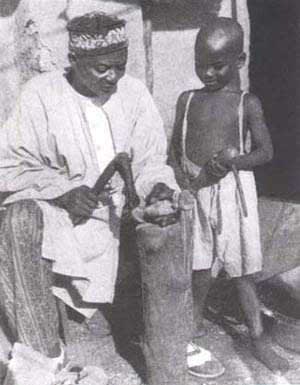
As you may have noticed the next Lempertz sale in Brussels features multiple figures carved by Thomas Ona (see below). Unfortunately they forgot to include a biography, so let me do that in their place here. From an article on Kunstpedia, written by David Zemanek, we learn:
When Uli Beier arrived in Nigeria there was more than just a dying of the Nigerian culture. Artists were faced with fewer commissions from the shrines and from private people for religious objects. So, many of them began to produce for the colonial tourism or they worked for the churches. A famous example of a great carver was Thomas Ona Odulate of Ijebu Ode, who worked from the turn of the century into the the late fifties. He first worked at Ijebu Ode, later in Lagos, where he was well known for his gently satirical carvings of colonial administrators, lawyers, missionaries made as souvenirs for the English.
Two years after the publication of this article, William Ayodele Odulate (one of the children of Thomas Ona) made a very interesting comment with some corrections and additions on the Kunstpedia website.
Thomas Onajeje Odulate was my father. I am standing right beside him. Picture taken at Tokunbo Street, Lagos. I am the only surviving child of his five children. He worked in Ikorodu (not Ijebu-Ode) and Lagos. He belonged to the ruling Mosene family of Ikorodu, Lagos State. He died in November 1952 and is buried in front of the Mosene compound, Ikorodu.
We learn more on the website of the Hearst Museum of Anthropology:
After moving to Lagos, Ona produced great quantities of novel woodcarvings depicting both colonials and Yoruba. Among the former were administrators, soldiers, lawyers, doctors, butchers, missionaries, polo players, married couples, even Queen Victoria. The Yoruba included both traditional roles and new, colonial occupations: mothers and children, masked dancers, kings and messengers, hunters, policemen, and postmen. Almost all were sold to the British; while some were commissioned, most were made in advance and then marketed.
While Ona’s figures are pioneering in subject matter, they are traditional in style. They follow usual Yoruba proportions, with a large head equal in size to the torso and legs. Ona used the traditional Yoruba carving tools of adze and knife. He painted the figures in red and black ink, white shoe polish, leaving the natural tan of the wood. However, unlike traditional Yoruba sculpture, which is usually carved out of single piece of wood, many of Ona’s carvings have separate parts, such as hats, guns, books, mallets, or umbrellas. And like most tourist arts, Ona’s sculpture often exists in multiple, similar versions. While they seem to be satirical or caricatures, and have been so identified, Ona told Bascom that his works simply showed how he viewed the world around him.
I could trace circa hundred works by his hand, making him the most prolific African sculptor of the first half of the twentieth century. For further reading:
– Nigeria: a quarterly magazine of general interest, June 1938, 14, p.138
– William Bascom, Modern African figurines: satirical or just stylistic?, Lore, 1957, 7(4), cover, pp.118-126
